#spacelaunchsystem
Text
The Artemis I Mission: To the Moon and Back
The Artemis I mission was the first integrated test of the Orion spacecraft, the Space Launch System (SLS) rocket, and Exploration Ground Systems at NASA’s Kennedy Space Center in Florida. We’ll use these deep space exploration systems on future Artemis missions to send astronauts to the Moon and prepare for our next giant leap: sending the first humans to Mars.
Take a visual journey through the mission, starting from launch, to lunar orbit, to splashdown.
Liftoff

The SLS rocket carrying the Orion spacecraft launched on Nov. 16, 2022, from Launch Complex 39B at NASA’s Kennedy Space Center in Florida. The world’s most powerful rocket performed with precision, meeting or exceeding all expectations during its debut launch on Artemis I.
"This is Your Moment"

Following the successful launch of Artemis I, Launch Director Charlie Blackwell-Thompson congratulates the launch team.
“The harder the climb, the better the view,” she said. “We showed the space coast tonight what a beautiful view it is.”
That's Us

On Orion’s first day of flight, a camera on the tip of one of Orion’s solar arrays captured this image of Earth.
Inside Orion

On the third day of the mission, Artemis I engineers activated the Callisto payload, a technology demonstration developed by Lockheed Martin, Amazon, and Cisco that tested a digital voice assistant and video conferencing capabilities in a deep space environment.
In the image, Commander Moonikin Campos occupies the commander’s seat inside the spacecraft. The Moonikin is wearing an Orion Crew Survival System suit, the same spacesuit that Artemis astronauts will use during launch, entry, and other dynamic phases of their missions. Campos is also equipped with sensors that recorded acceleration and vibration data throughout the mission that will help NASA protect astronauts during Artemis II.
The Moonikin was one of three “passengers” that flew aboard Orion. Two female-bodied model human torsos, called phantoms, were aboard. Zohar and Helga, named by the Israel Space Agency (ISA) and the German Aerospace Center (DLR) respectively, supported the Matroshka AstroRad Radiation Experiment (MARE), an experiment to provide data on radiation levels during lunar missions.
Snoopy, wearing a mock orange spacesuit, also can be seen floating in the background. The character served as the zero-gravity indicator during the mission, providing a visual signifier that Orion is in space.
Far Side of the Moon

A portion of the far side of the Moon looms large in this image taken by a camera on the tip of one of Orion’s solar arrays on the sixth day of the mission.
First Close Approach

The Orion spacecraft captured some of the closest photos of the Moon from a spacecraft built for humans since the Apollo era — about 80 miles (128 km) above the lunar surface. This photo was taken using Orion’s optical navigational system, which captures black-and-white images of the Earth and Moon in different phases and distances.
Distant Retrograde Orbit
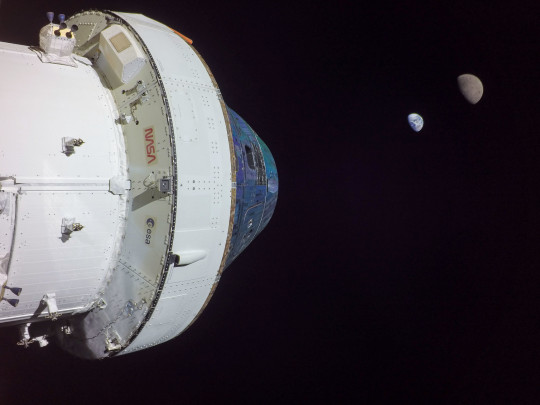
Orion entered a distant retrograde orbit around the Moon almost two weeks into the mission. The orbit is “distant” in the sense that it’s at a high altitude approximately 50,000 miles (80,467 km) from the surface of the Moon. Orion broke the record for farthest distance of a spacecraft designed to carry humans to deep space and safely return them to Earth, reaching a maximum distance of 268,563 miles (432,210 km).
Second Close Approach

On the 20th day of the mission, the spacecraft made its second and final close approach to the Moon flying 79.2 miles (127.5 km) above the lunar surface to harness the Moon’s gravity and accelerate for the journey back to Earth.
Cameras mounted on the crew module of the Orion spacecraft captured these views of the Moon’s surface before its return powered flyby burn.
Heading Home

After passing behind the far side of the Moon on Flight Day 20, Orion powered a flyby burn that lasted approximately 3 minutes and 27 seconds to head home. Shortly after the burn was complete, the Orion spacecraft captured these views of the Moon and Earth, which appears as a distant crescent.
Parachutes Deployed
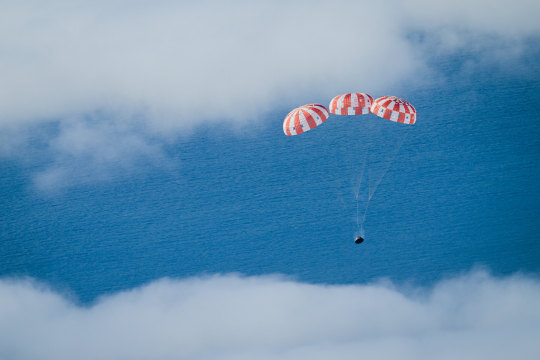
Prior to entering the Earth’s atmosphere, Orion’s crew module separated from its service module, which is the propulsive powerhouse provided by ESA (European Space Agency). During re-entry, Orion endured temperatures about half as hot as the surface of the Sun at about 5,000 degrees Fahrenheit (2,760 degrees Celsius). Within about 20 minutes, Orion slowed from nearly 25,000 mph (40,236 kph) to about 20 mph (32 kph) for its parachute-assisted splashdown.
Splashdown

On Dec. 11, the Orion spacecraft splashed down in the Pacific Ocean off the coast of California after traveling 1.4 million miles (2.3 million km) over a total of 25.5 days in space. Teams are in the process of returning Orion to Kennedy Space Center in Florida. Once at Kennedy, teams will open the hatch and unload several payloads, including Commander Moonikin Campos, the space biology experiments, Snoopy, and the official flight kit. Next, the capsule and its heat shield will undergo testing and analysis over the course of several months.
Make sure to follow us on Tumblr for your regular dose of space!
#Artemis#LunarMission#SpaceLaunchSystem#Rocket#Space#MegaMoonRocket#Moon#Spacecraft#Orion#NASAMoonSnap#Moonikin#Earth#LunarOrbit#Splashdown#Launch
2K notes
·
View notes
Text

#IFTTT#Flickr#nasa#marshallspaceflightcenter#msfc#rocket#space#artemis#spacelaunchsystem#moon2mars#michoudassemblyfacility#artemisiii
52 notes
·
View notes
Text

#IFTTT#Flickr#nasa#marshallspaceflightcenter#msfc#rocket#space#artemis#spacelaunchsystem#moon2mars#rocketengine#orion
7 notes
·
View notes
Text
NASA Adjusts Timeline for Artemis Missions to Ensure Astronaut Safety

NASA has officially postponed its ambitious plans to send astronauts on a mission around the moon, citing safety concerns related to its new rocket system. The move comes as the space agency prioritizes addressing issues with the Space Launch System rocket and Orion spacecraft, crucial components of NASA’s deep space exploration endeavors.
Artemis II Launch Rescheduled to September 2025
The anticipated launch of Artemis II, originally scheduled for later this year, has now been rescheduled to September 2025. This mission marks a significant milestone as it will be the first with a crew on board the Space Launch System rocket and Orion spacecraft. Four astronauts are slated to embark on a 10-day journey, circumnavigating the moon as part of NASA’s broader mission objectives.
Artemis Mission III Shifted to September 2026
In conjunction with the Artemis II delay, NASA also adjusted the timeline for the Artemis III mission. This mission, set to launch in September 2026, aims to achieve another historic feat – landing a NASA crew, including the first woman and the first person of color, on the lunar surface for the first time since 1972.
Artemis IV Mission to the First Lunar Space Station Remains on Track for 2028
Despite the alterations to the initial Artemis missions, NASA assures that the subsequent manned mission, Artemis IV, to the first space station around the moon, is still on track for its planned launch in 2028. The Artemis program represents NASA’s commitment to renewed lunar exploration and serves as a stepping stone for future deep space endeavors.
NASA Artemis Missions Moon Landing Delayed
youtube
NASA Emphasizes Commitment to Astronaut Safety
In response to the delays, NASA Administrator Bill Nelson emphasized the space agency’s unwavering commitment to astronaut safety. He stated, “We are returning to the moon in a way we never have before, and the safety of our astronauts is NASA’s top priority as we prepare for future Artemis missions.” The Artemis program aims to leverage commercial and international partnerships to expand humanity’s understanding of our solar system.
Ongoing Testing and Investigations
NASA continues to conduct rigorous testing of safety and life support systems, addressing issues that have surfaced during the process. The space agency is actively investigating the unexpected loss of a part of the unmanned Artemis I’s heat shield. The findings from this probe are expected to be concluded in the spring.
Delays Seen as Necessary for Astronaut Safety and Exploration Goals
Catherine Koerner, the Associate Administrator of NASA’s Exploration Systems Development Mission Directorate, acknowledged the challenges associated with pioneering capabilities and operations. She affirmed that the ongoing delays are crucial for ensuring astronaut safety and represent significant progress towards establishing sustained exploration of Earth’s nearest neighbor under the Artemis program.
As NASA navigates the complexities of deep space exploration, these adjustments underscore the dedication to mitigating risks and laying the groundwork for future lunar missions.
#ArtemisMission#NASAExploration#MoonMission#AstronautSafety#SpaceLaunchSystem#OrionSpacecraft#ArtemisII#Youtube
0 notes
Text
Più flessibili e resistenti le tute spaziali per Artemis 3
Più flessibili le nuove tute per la Luna. Preparate dall’azienda Axiom per la missione Artemis III. Per il momento è nera, con strisce arancioni e blu, ma nella sua versione definitiva sarà bianca, la nuova tuta per gli astronauti che nel 2025 torneranno a mettere piede sulla Luna con la missione Artemis 3.
Il prototipo, presentato dalla compagnia Axiom in collaborazione con la Nasa, mostra una tuta più funzionale di quelle usate per le missioni Apollo: avrà luci sull'elmetto per esplorare, uno zaino sulle spalle con il sistema di sopravvivenza, stivali ben isolati per proteggere dal suolo gelido e giunture flessibili per braccia e gambe per garantire una maggiore mobilità.

Particolare del prototipo della nuova tuta per il ritorno alla Luna. La versione definitiva sarà bianca (fonte: Axiom Space)
La nuova tuta si chiama AxEMU (Axiom Extravehicular Mobility Unit) ed è stata progettata "per fornire maggiore flessibilità, maggiore protezione dall'ambiente ostile e strumenti specializzati, in modo da soddisfare le esigenze di esplorazione ed espandere le opportunità scientifiche", spiega Axiom, che per questo progetto specifico ha siglato un contratto da 228 milioni di dollari con la Nasa. "Utilizzando tecnologie innovative e un design flessibile, queste tute spaziali consentiranno una maggiore esplorazione della Luna".
Le dimensioni possono essere adattate alle esigenze di indosso di una più vasta gamma di astronauti. Innovative articolazioni morbide e dure forniranno una maggiore libertà di movimento per camminare più facilmente sulla Luna, eseguire compiti geologici e scientifici in modo più preciso e traslare più facilmente sulle stazioni spaziali, il tutto massimizzando il comfort.
"Le tute sono la prima parte del programma per la Luna che sta diventando realtà", afferma Lara Kearney, a capo del programma per le attività extraveicolari e la mobilità umana in superficie della Nasa presso il Johnson Space Center. "Stavolta atterreremo al polo Sud - aggiunge Bob Cabana, amministratore associato della Nasa - è sarà una sfida imparare come operare e sfruttare le risorse lunari nel lungo periodo".
Prosegue così la collaborazione con i privati che fin dall’inizio ha caratterizzato il programma Artemis. Con le aziende sono stati infatti messi a punto il più grande razzo mai costruito, lo Space Launch System che ha portato in orbita la capsula Orion nella missione Artemis I, la stessa capsula Orion e i sistemi di Terra che la controllano, e la collaborazione fra agenzie spaziali e privati è anche alla base del progetto per la costruzione della futura stazione spaziale Gateway destinata all’orbita lunare, i sistemi di atterraggio e i moduli pressurizzati per la futura base lunare.
Read the full article
0 notes
Text

#IFTTT#Flickr#nasa#marshallspaceflightcenter#msfc#rocket#space#artemis#spacelaunchsystem#moon2mars#rocketengine
0 notes
Photo
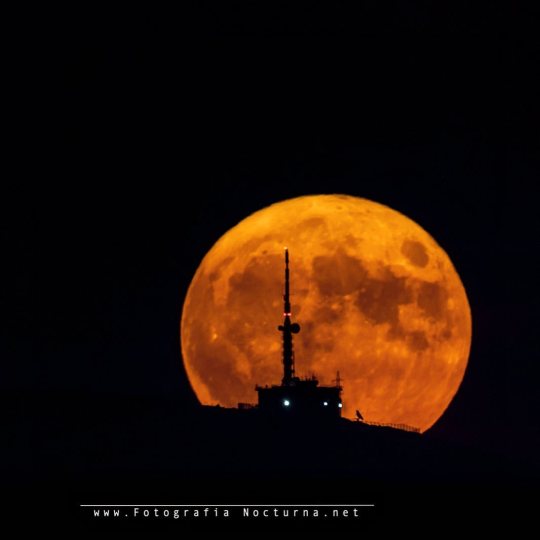
Espectacular el lanzamiento del #SLS visto en directo por #Youtube comienza el regreso de la humanidad a la Luna #Artemis1 #SpaceLaunchSystem #NASA Nave #Orion ⬇️ Foto de la #Luna #Lunallena por la antena de #PeñaCabarga #Cantabria #España ⬇️ Time-lapse en ‘Historias’ ⬇️ #FotografiaNocturna #Cantabrianocturna #FotografiaNocturnaCantabria #Cantabriaturismo #comparteCantabria #NosvemosenCantabria #igerscantabria #cantabria_y_turismo #Cantabriainfinita #cantabriamasxdescubrir #Cantabriacaptura #moon #fullmoon #moonlight #moonlovers 🔻 🔻🔻🔻🔻 𝚆𝙴𝙱 🔻🔻🔻🔻🔻 📷www.fotografianocturna.net 🔺🔺🔺🔺🔺🔺🔺🔺🔺🔺🔺🔺 ʝµℓเσ 2022 (en Peña Cabarga) https://www.instagram.com/p/ClBBX0YLK_e/?igshid=NGJjMDIxMWI=
#sls#youtube#artemis1#spacelaunchsystem#nasa#orion#luna#lunallena#peñacabarga#cantabria#españa#fotografianocturna#cantabrianocturna#fotografianocturnacantabria#cantabriaturismo#compartecantabria#nosvemosencantabria#igerscantabria#cantabria_y_turismo#cantabriainfinita#cantabriamasxdescubrir#cantabriacaptura#moon#fullmoon#moonlight#moonlovers
1 note
·
View note
Photo

#SaturnV rollout with #Artemis rollout #NASA #KennedySpaceCenter 🚀✨ —-👉 @tiktokastronot 🧑🚀🚫 #SLS #spacelaunchsystem #Rocket #Launch #Space #Astronaut #Artemis1 #MoonLanding #spacecraft #spacehistory #spaceexploration #spacenews #spaceupdates #spacecraftpics #apolloprogram #artemismission #spaceflight #TikTokAstroNOT 🧑🚀🚫 (at Launch Complex 39 - Pad B) https://www.instagram.com/p/ChZfVfSui-8/?igshid=NGJjMDIxMWI=
#saturnv#artemis#nasa#kennedyspacecenter#sls#spacelaunchsystem#rocket#launch#space#astronaut#artemis1#moonlanding#spacecraft#spacehistory#spaceexploration#spacenews#spaceupdates#spacecraftpics#apolloprogram#artemismission#spaceflight#tiktokastronot
0 notes
Photo
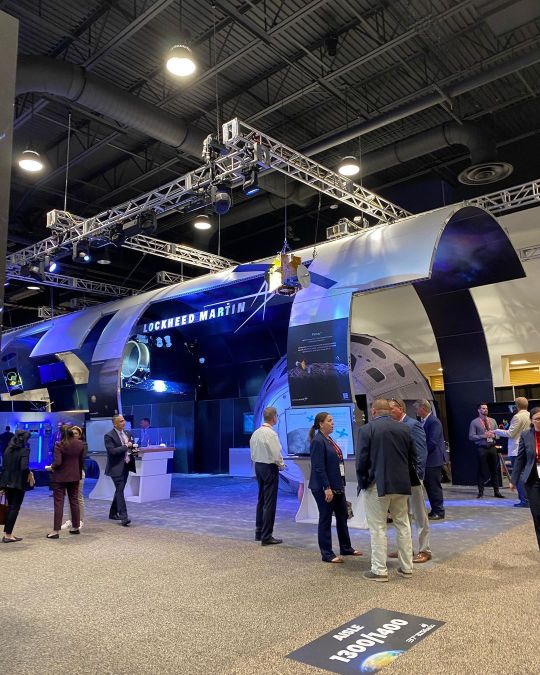
Model space capsules, habitats, and more! • 📍 Place: The Broadmoor 🗺 Location: Colorado Springs, CO 🎞 Camera: iPhone 11 Pro Max 👁🗨 Valid Tag: #37thSpaceSymposium • ▪️ • 🔳 • ▫️ • ================================= #space #tothemoon #astronaut #spacelaunchsystem #astronomy #wanderlust #nasa #canadianspaceagency #spacecapsule #sls #spacemodel #sierra #colorado #verus_animus #lockheedmartin #FueledByWanderlust #GravityHurts #NoTime2Sleep #spacehabitat #spacesymposium #verusanimus #spacefoundation #coloradosprings #wayupcolorado #sempersupra #planetaryscience #37space #moon #thebroadmoor ================================= (at Colorado Springs, Colorado) https://www.instagram.com/p/CeHD8copMiF/?igshid=NGJjMDIxMWI=
#37thspacesymposium#space#tothemoon#astronaut#spacelaunchsystem#astronomy#wanderlust#nasa#canadianspaceagency#spacecapsule#sls#spacemodel#sierra#colorado#verus_animus#lockheedmartin#fueledbywanderlust#gravityhurts#notime2sleep#spacehabitat#spacesymposium#verusanimus#spacefoundation#coloradosprings#wayupcolorado#sempersupra#planetaryscience#37space#moon#thebroadmoor
1 note
·
View note
Text

Artemis I, you are going to the Moon!
At 1:47 am EST, currently the world’s most powerful rocket, the Space Launch System, launched the Orion spacecraft from launch pad 39B in Florida to make its journey to Earth’s natural orbiting satellite—The Moon. The Artemis I mission is a flight test and is an opportunity to better understand the integrated system before we fly astronauts aboard on Artemis II.
But the mission has only just begun… Through the mission, we'll have live coverage of Orion's closest approach to the Moon, an inside look of Mission Control, and more!
NASA is returning to the lunar surface to not only create a long-lasting presence on the Moon and eventually Mars, but to unlock new scientific discoveries, and inspire the next generations of space explorers —The Artemis Generation.
Stay tuned on social media for more updates throughout the mission. GO ARTEMIS!
#Artemis #NASA #SpaceLaunchSystem #Orion #Moon #Rocket #Space #Exploration
0 notes
Photo
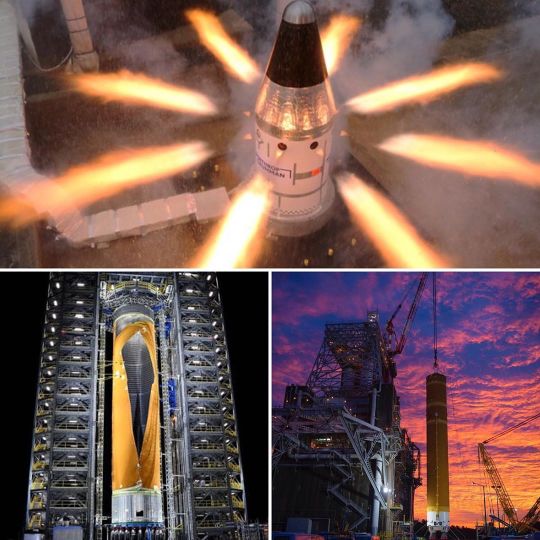
Critical NASA testing for the Artemis Program. The recent safety tests of the Space Launch System designed to launch astronauts to the Moon have been performed on both the fuel tank and the Orion capsule.
.
The fuel tank was subjected to pressures greater than 260% of that experienced during flight at which point it lost its structural integrity and split open (bottom panels).
.
On the other hand, recent tests of the Orion capsule showcased the ability of the Altitude Control Motor (top) that is designed to steer astronauts away from danger in the event of a rocket 🚀 malfunction.
.
These recent tests of both the SLS and the capsule that will be used to taxi astronauts to space shows NASA’s commitment to safety in the new space race.
.
As both public and private agencies and companies race towards the Moon, error free launches will be critical to their success.
.
Credit: NASA / public domain.
.
#nasa #astronaut #astronauts #spacelaunchsystem #artemis #rocketengineering #rocketengine #orioncapsule #nasa🚀
https://www.instagram.com/p/B9mMejmJ7Yb/?igshid=cbjnnugkp1sz
#nasa#astronaut#astronauts#spacelaunchsystem#artemis#rocketengineering#rocketengine#orioncapsule#nasa🚀
1 note
·
View note
Text
Follow NASA’s Artemis I Moon Mission: Live Tracker, Latest Images, and Videos
youtube
On Nov. 16, 2022, the Artemis I mission officially began with the launch of the Orion spacecraft atop the Space Launch System rocket. The rocket and spacecraft lifted off from historic Launch Complex 39B at NASA’s Kennedy Space Center in Florida.
Now, the Orion spacecraft is about halfway through its journey around the Moon. Although the spacecraft is uncrewed, the Artemis I mission prepares us for future missions with astronauts, starting with Artemis II.
Stay up-to-date with the mission with the latest full-resolution images, mission updates, on-demand and live video.
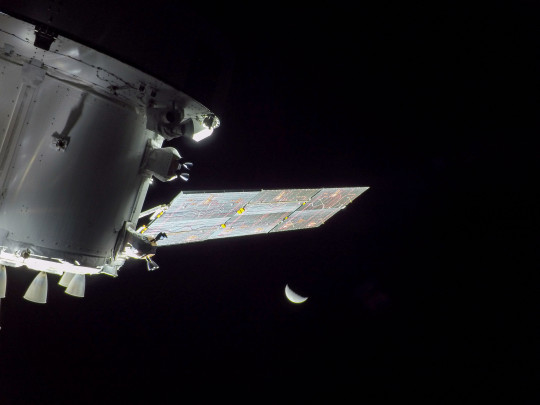
Imagery:
Find full-resolution images from the Orion spacecraft as they are released here.
Launch imagery can be found here. When Orion splashes down in the Pacific Ocean on Dec. 11, the images will be available here, as well!
youtube
Videos:
This playlist contains informational videos, as well as upcoming and past live events, about Artemis I.
You can watch a livestream of the Artemis I mission here. (Just a note: the livestream may cut off during moments when the Orion team needs higher bandwidth for activities.)
Keep yourself updated on the upcoming broadcasts of Artemis milestones with the NASA TV schedule.
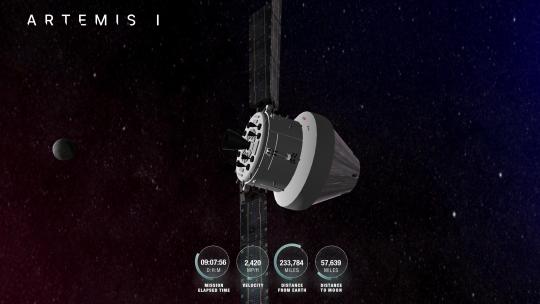
Trackers:
Our Artemis I Tracker uses live telemetry data streamed directly from Mission Control Center in Houston to show Orion position, attitude, solar array positions, and thruster firings throughout the mission.
“Eyes on the Solar System” shows Orion's position along the Artemis I trajectory and in relation to other NASA spacecraft and objects in the solar system.
“DSN Now” shows which antenna on Earth’s Deep Space Network is communicating with Orion.
youtube
Updates:
Read up on where Orion is and what’s next in the Artemis I mission with the Mission Blog.
Thank you so much for following with us on this historic mission. Go Artemis!
Make sure to follow us on Tumblr for your regular dose of space!
#nasa#space#moon#science#technology#artemis#nasamoonsnap#orion#megamoonrocket#sls#spacelaunchsystem#lunarmission#Youtube
1K notes
·
View notes
Text

#IFTTT#Flickr#nasa#nasasmarshallspaceflightcenter#nasamarshall#marshall#msfc#centennialchallenges#cubequest#rocket#space#artemis#spacelaunchsystem#moon2mars#artemisi
23 notes
·
View notes
Photo

Inside the Vertical Assembly Center https://ift.tt/319F7qB
1 note
·
View note
Photo
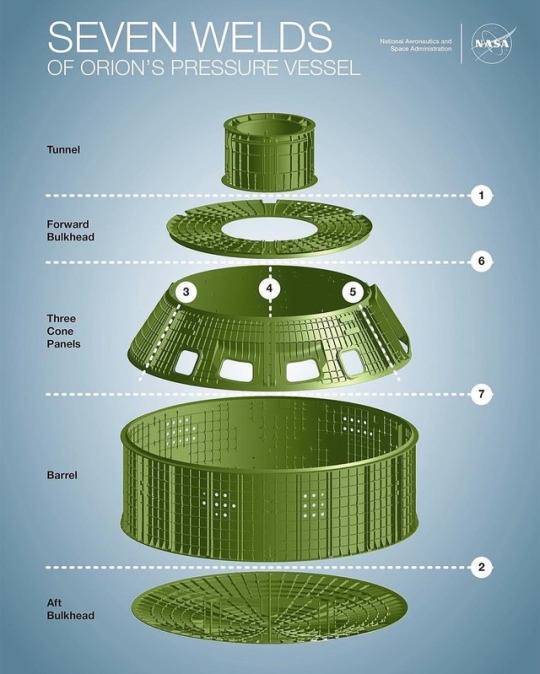
Repost from @nasa__sls using @RepostRegramApp - The Orion Spacecraft requires 3 major structural components - all prefabricated and friction welded together. They’re made from an aluminum alloy with some steel components, that when fully manufactured will be one of the strongest crew capsules ever made, and one of the safest. So far 3 have been made at the NASA rocket factory, while 2 more are in order at the moment. They’re capable of being reused and refurbished 10 times . Credit: NASA #nasa #orion #orioncapsule #orionspacecraft #spacelaunchsystem #sls #nasasocial #factsheet #explorationmission #rocket #mars
#nasa#orion#orioncapsule#orionspacecraft#spacelaunchsystem#sls#nasasocial#factsheet#explorationmission#rocket#mars
26 notes
·
View notes
Text
Artemis, la capsula Orion in viaggio verso la Luna
Lanciato il razzo del ritorno alla Luna, il decollo alle 7:45 ora italiana. Lanciato il razzo Sls di Artemis 1, la prima missione senza equipaggio del programma Artemis, diretta all'orbita lunare. Il lancio dello Space Launch System della Nasa è avvenuto dal Kennedy Space Center a Cape Canaveral. La prima manovra per mantenere la capsula Orion in rotta verso la Luna è prevista alle 16:51 ora italiana
Si è alzato in volo questa mattina, alle 7:47 ora italiana, il razzo Sls (Space Launch System) dalla base di lancio 39B presso il Kennedy Space Center della Nasa. Sfrecciando nel cielo notturno della Florida, il lanciatore più potente al mondo ha dato così inizio alla missione Artemis 1, che vedrà la capsula Orion spingersi fin oltre la Luna, per rientrare poi sulla Terra tra circa 25 giorni.
La missione, un test di volo senza equipaggio, è il primo e fondamentale segmento del programma Artemis per l’esplorazione della Luna, in vista della prossima missione, Artemis II, che riporterà gli astronauti sul nostro satellite naturale. Sarà il primo ritorno dell’umanità, e la prima volta per astronaute donne, sulla Luna dai tempi del programma Apollo, della cui ultima missione – l’Apollo 17 – ricorre il cinquantesimo anniversario proprio il prossimo dicembre.
«Questo test di volo senza equipaggio spingerà Orion ai limiti, nelle asperità dello spazio profondo, aiutandoci a prepararci per l’esplorazione umana della Luna e, infine, di Marte», ha dichiarato l’amministratore della Nasa Bill Nelson.

Dopo aver raggiunto la sua orbita iniziale, Orion ha dispiegato i pannelli solari e gli ingegneri hanno iniziato a eseguire i controlli dei sistemi del veicolo spaziale. Dopo circa un’ora e mezza di volo, il motore dello stadio superiore del razzo si è acceso con successo per circa 18 minuti per dare a Orion una potente spinta, necessaria a inviarlo fuori dall’orbita terrestre.
Orion si è separato dal suo stadio superiore ed è in rotta verso la Luna alimentato dal modulo di servizio, lo European Service Module fornito dall’Agenzia spaziale europea (Esa), uno dei partner internazionali del programma Artemis. Progettato e supervisionato dall’Esa, il modulo di servizio di Orion è la parte del veicolo spaziale che fornisce aria, elettricità e propulsione alla capsula. «Il modulo di servizio europeo e la navicella spaziale Orion provengono da decenni di eccellente collaborazione tra Esa e Nasa», ha commentato il Direttore generale dell’Esa, Josef Aschbacher. L’Europa, un partner importante del programma di esplorazione guidato dalla Nasa, sarà coinvolta nei prossimi anni con il lancio di moduli europei per costruire il Lunar Gateway, una nuova stazione spaziale internazionale in orbita attorno a Terra e Luna, e la partecipazione di astronauti europei all’esplorazione lunare entro la fine di questo decennio.
Il modulo di servizio eseguirà anche la prima di una serie di manovre per mantenere Orion in rotta verso la Luna circa otto ore dopo il lancio, alle 16:51 ora italiana. Nei prossimi giorni, i controllori di missione del Johnson Space Center della Nasa, a Houston, effettueranno ulteriori verifiche e correzioni di rotta, se necessario. Si prevede che Orion si avvicinerà alla Luna il 21 novembre, eseguendo un flyby della superficie lunare nel suo percorso verso quella che viene chiamata “orbita retrograda distante”, un’orbita altamente stabile che porterà la capsula a ben 64mila chilometri al di là della Luna, oltre le distanze raggiunte dalle missioni Apollo.
«Ci è voluto molto per arrivare qui, ma Orion è ora in viaggio verso la Luna», ha dichiarato Jim Free, vice amministratore associato della Nasa per l’Exploration Systems Development Mission Directorate. «Questo lancio di successo significa che la Nasa e i nostri partner sono sulla buona strada per esplorare lo spazio più lontano che mai a beneficio dell’umanità».
Nelle prossime ore, si dispiegheranno anche una serie di dieci piccoli satelliti, o cubesat: ciascuno di essi ha una missione dedicata allo studio del Sistema solare oppure alla dimostrazione di tecnologie che potrebbero giovare alla progettazione di future missioni per esplorare la Luna e oltre. Tra questi anche ArgoMoon, cubesat dell’Agenzia spaziale italiana (Asi) realizzato da Argotec, che fornirà alla Nasa le immagini significative a conferma della corretta esecuzione delle operazioni del vettore Sls, che al momento del rilascio dei CubeSat non potrà inviare segnali verso Terra.
«L’inizio di una nuova grande collaborazione internazionale che vede ancora una volta l’Italia e l’intera filiera industriale tra i protagonisti, continuando un percorso che ci ha resi nel tempo partner di eccellenza nella sfida dell’esplorazione spaziale», ha dichiarato il presidente dell’Asi, Giorgio Saccoccia. «Europa, Usa e molti altri paesi nel mondo uniti in unico obiettivo destinato al progresso di tutta l’umanità: tornare sulla Luna per restarci! A cinquant’anni dall’ultima missione Apollo, oggi, con Artemis I andiamo sulla Luna per fare nuove scoperte, imparare a vivere e lavorare oltre i confini del nostro pianeta. Questa missione rappresenta un grande momento per tutti coloro che stanno contribuendo a questo entusiasmante progetto, ma anche per tutti coloro che guardano allo spazio, alla tecnologia, al futuro con gli occhi di chi crede nell’ingegno umano e non smette di sognare».
Artemis 1, lancio avvenuto: la capsula Orion è in volo verso la Luna
Read the full article
#ArgoMoon#artemis#asi#baselunare#cubesat#Esa#esplorazionelunare#LUNA#LunarGateway#Nasa#Orion#spacelaunchsystem
1 note
·
View note